Expression of multiple P2X receptors by glossopharyngeal neurons projecting to rat carotid body O2-chemoreceptors: role in nitric oxide-mediated efferent inhibition
- PMID: 16971532
- PMCID: PMC6674604
- DOI: 10.1523/JNEUROSCI.1672-06.2006
Expression of multiple P2X receptors by glossopharyngeal neurons projecting to rat carotid body O2-chemoreceptors: role in nitric oxide-mediated efferent inhibition
Abstract
In mammals, ventilation is peripherally controlled by the carotid body (CB), which receives afferent innervation from the petrosal ganglion and efferent innervation from neurons located along the glossopharyngeal nerve (GPN). GPN neurons give rise to the "efferent inhibitory" pathway via a plexus of neuronal nitric oxide (NO) synthase-positive fibers, believed to be responsible for CB chemoreceptor inhibition via NO release. Although NO is elevated during natural CB stimulation by hypoxia, the underlying mechanisms are unclear. We hypothesized that ATP, released by rat CB chemoreceptors (type 1 cells) and/or red blood cells during hypoxia, may directly activate GPN neurons and contribute to NO-mediated inhibition. Using combined electrophysiological, molecular, and confocal immunofluorescence techniques, we detected the expression of multiple P2X receptors in GPN neurons. These receptors involve at least four different purinergic subunits: P2X2 [and the splice variant P2X2(b)], P2X3, P2X4, and P2X7. Using a novel coculture preparation of CB type I cell clusters and GPN neurons, we tested the role of P2X signaling on CB function. In cocultures, fast application of ATP, or its synthetic analog 2',3'-O-(4 benzoylbenzoyl)-ATP, caused type I cell hyperpolarization that was prevented in the presence of the NO scavenger 2-(4-carboxyphenyl)-4,4,5,5-tetramethyl-imidazoline-1-oxyl-3-oxide potassium. These data suggest that ATP released during hypoxic stress from CB chemoreceptors (and/or red blood cells) will cause GPN neuron depolarization mediated by multiple P2X receptors. Activation of this pathway will lead to calcium influx and efferent inhibition of CB chemoreceptors via NO synthesis and consequent release.
Figures

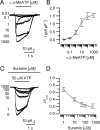

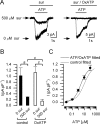
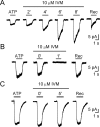


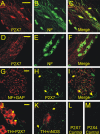

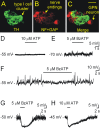

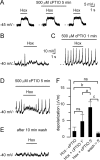

Similar articles
-
Purinergic stimulation of carotid body efferent glossopharyngeal neurones increases intracellular Ca2+ and nitric oxide production.Exp Physiol. 2013 Jul;98(7):1199-212. doi: 10.1113/expphysiol.2013.072058. Epub 2013 Mar 22. Exp Physiol. 2013. PMID: 23525247
-
Expression of P2X2 and P2X3 receptor subunits in rat carotid body afferent neurones: role in chemosensory signalling.J Physiol. 2001 Dec 15;537(Pt 3):667-77. doi: 10.1111/j.1469-7793.2001.00667.x. J Physiol. 2001. PMID: 11744746 Free PMC article.
-
Co-release of ATP and ACh mediates hypoxic signalling at rat carotid body chemoreceptors.J Physiol. 2000 May 15;525 Pt 1(Pt 1):143-58. doi: 10.1111/j.1469-7793.2000.t01-1-00143.x. J Physiol. 2000. PMID: 10811733 Free PMC article.
-
Autonomic innervation of the carotid body: role in efferent inhibition.Respir Physiol Neurobiol. 2007 Jul 1;157(1):83-92. doi: 10.1016/j.resp.2007.01.020. Epub 2007 Feb 8. Respir Physiol Neurobiol. 2007. PMID: 17353154 Review.
-
Modulation of the carotid body sensory discharge by NO: an up-dated hypothesis.Respir Physiol Neurobiol. 2012 Nov 15;184(2):149-57. doi: 10.1016/j.resp.2012.04.005. Epub 2012 Apr 20. Respir Physiol Neurobiol. 2012. PMID: 22543195 Review.
Cited by
-
P2Y2 receptor activation opens pannexin-1 channels in rat carotid body type II cells: potential role in amplifying the neurotransmitter ATP.J Physiol. 2012 Sep 1;590(17):4335-50. doi: 10.1113/jphysiol.2012.236265. Epub 2012 Jun 25. J Physiol. 2012. PMID: 22733659 Free PMC article.
-
Expanding role of ATP as a versatile messenger at carotid and aortic body chemoreceptors.J Physiol. 2013 Jan 15;591(2):415-22. doi: 10.1113/jphysiol.2012.234377. Epub 2012 Nov 19. J Physiol. 2013. PMID: 23165772 Free PMC article. Review.
-
Resolving the Ionotropic P2X4 Receptor Mystery Points Towards a New Therapeutic Target for Cardiovascular Diseases.Int J Mol Sci. 2020 Jul 15;21(14):5005. doi: 10.3390/ijms21145005. Int J Mol Sci. 2020. PMID: 32679900 Free PMC article. Review.
-
Increased endogenous nitric oxide release by iron chelation and purinergic activation in the rat carotid body.Open Biochem J. 2007;1:1-6. doi: 10.2174/1874091X00701010001. Epub 2007 Jun 15. Open Biochem J. 2007. PMID: 18949066 Free PMC article.
-
Synaptic and paracrine mechanisms at carotid body arterial chemoreceptors.J Physiol. 2014 Aug 15;592(16):3419-26. doi: 10.1113/jphysiol.2013.269829. Epub 2014 Mar 24. J Physiol. 2014. PMID: 24665097 Free PMC article. Review.
References
-
- Bianchi BR, Lynch KJ, Touma E, Niforatos W, Burgard EC, Alexander KM, Park HS, Yu H, Metzger R, Kowaluk E, Jarvis MF, van Biesen T. Pharmacological characterization of recombinant human and rat P2X receptor subtypes. Eur J Pharmacol. 1999;376:127–138. - PubMed
-
- Bo X, Zhang Y, Nassar M, Burnstock G, Schoepfer R. A P2X purinoceptor cDNA conferring a novel pharmacological profile. FEBS Lett. 1995;375:129–133. - PubMed
-
- Brake AJ, Wagenbach MJ, Julius D. New structural motif for ligand-gated ion channels defined by an ionotropic ATP receptor. Nature. 1994;371:519–523. - PubMed
-
- Burnstock G. Purinergic signaling and vascular cell proliferation and death. Arterioscler Thromb Vasc Biol. 2002;22:364–373. - PubMed
-
- Buttigieg J, Nurse CA. Detection of hypoxia-evoked ATP release from chemoreceptor cells of the rat carotid body. Biochem Biophys Res Commun. 2004;322:82–87. - PubMed
Publication types
MeSH terms
Substances
LinkOut - more resources
Full Text Sources
Miscellaneous
